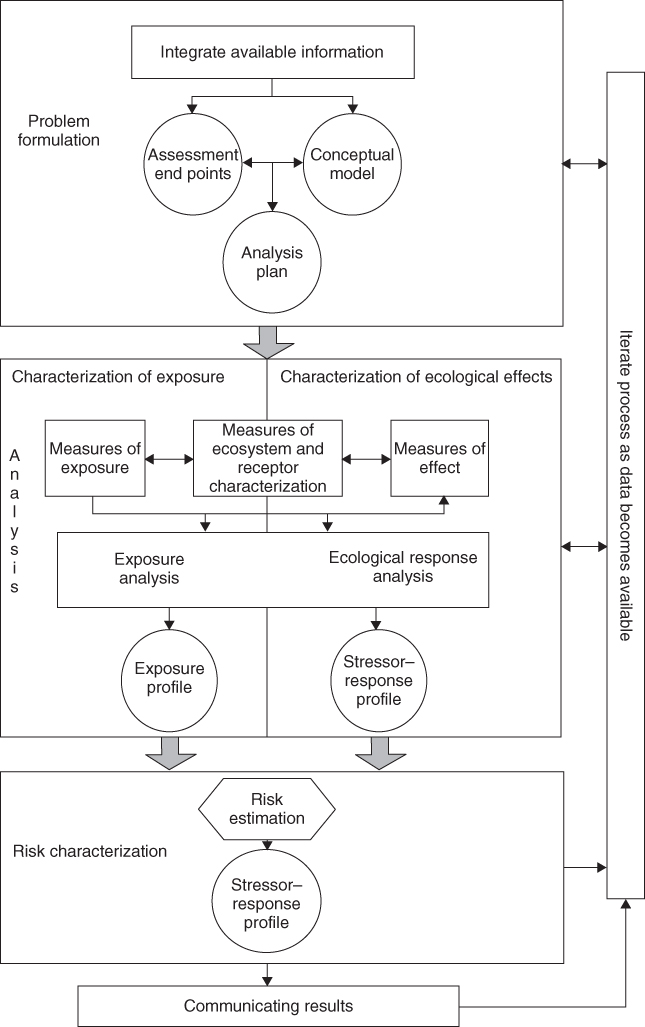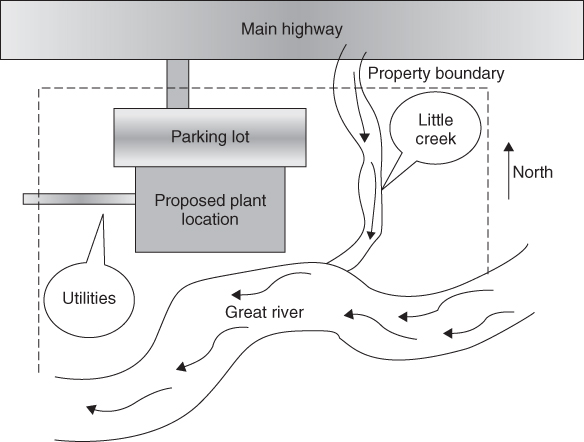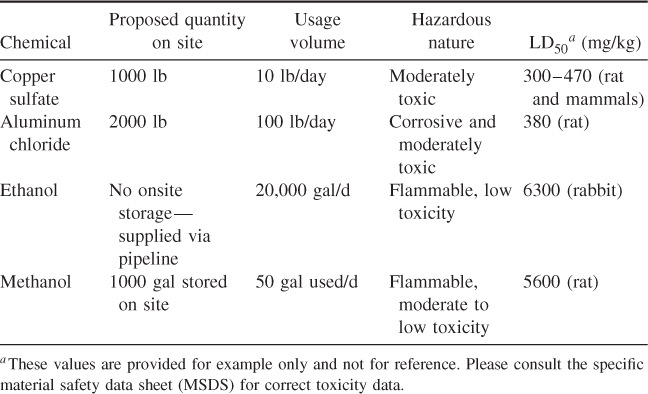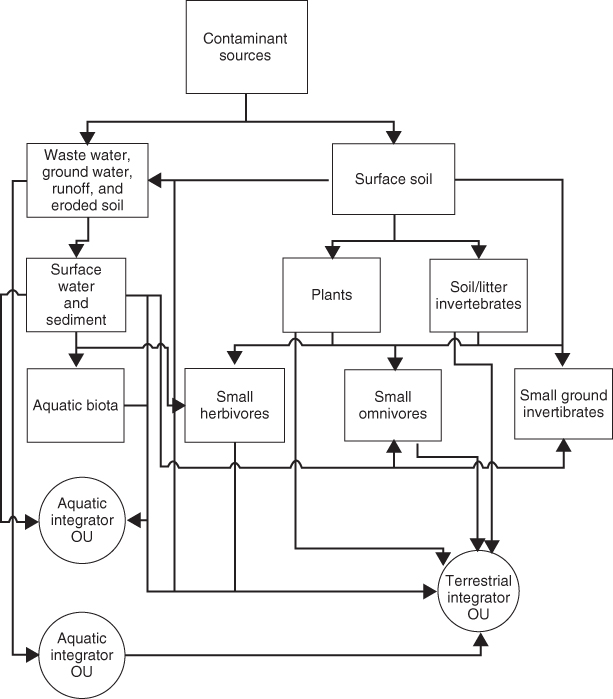4.8 Ecological Risk Assessment
Ecological risk assessment (ERA) is a process that is used to help determine what risks are posed by an industry, government, or other entity. It further provides a logical process to help eliminate or mitigate such threats.
An ERA evaluates the potential adverse effects that human activities have on the living organisms (plants and animals) that make up ecosystems. The risk assessment process provides a way to develop, organize, and present scientific information so that it is relevant to future and present environmental decisions. When conducted for a particular place such as a forest or wetland, the ERA process can be used to identify vulnerable and valued resources, prioritize data collection activity, and link human activities to their potential effects. ERA results provide a basis for comparing different management options and enabling decision makers and the public to make better informed decisions about the management of ecological resources (26).
As EPA guidance states, ERAs are used to support many types of management actions, including the regulation of hazardous waste sites, industrial chemicals, and pesticides, or the management of watersheds or other ecosystems affected by multiple nonchemical and chemical stressors. The ERA process has several features that contribute to effective environmental decision making (26):
- Through an iterative process, new information can be incorporated into risk assessments that can then be used to improve environmental decision making.
- Risk assessments can be used to express changes in ecological effects as a function of changes in exposure to stressors. This capability may be particularly useful to decision makers, who must evaluate tradeoffs, examine different alternatives, or determine the extent to which stressors must be reduced to achieve a given outcome.
- Risk assessments explicitly evaluate uncertainty. Uncertainty analysis describes the degree of confidence in the assessment and can help the risk manager focus research on those areas that will lead to the greatest reductions in uncertainty.
- Risk assessments provide a basis for comparing, ranking, and prioritizing risks. The results can also be used in cost-benefit and cost-effectiveness analyses that offer additional interpretation of the effects of alternative management options.
- Risk assessments consider management goals and objectives as well as scientific issues in developing assessment endpoints and conceptual models during problem formulation. Such initial planning activities help ensure that results will be useful to risk managers.
The ERA approach contained in this book follows the EPA guidelines (26). However, a search of the literature does present many other similar processes that can be used to assess ecological risk (27).
According to the EPA, the ERA process is based on two major elements:
These provide the focus for conducting the three phases of risk assessment as illustrated in Figure 4.2:
Figure 4.2 ERA process flow (26).

The three phases of risk assessment are enclosed by a dark solid line.
Problem formulation is the first phase. During problem formulation, the purpose for the assessment is developed, the problem is defined, and a plan for analyzing and characterizing risk is also developed. Initial work in problem formulation includes the integration of available information on potential sources of contaminates, potential stressors to the environment, potential effects, and ecosystem and receptor characteristics. From this information, two products are generated: assessment endpoints and conceptual models. Either product may be generated first (the order depends on the type of risk assessment), but both are needed to complete an analysis plan, the final product of problem formulation (26).
Analysis follows problem formulation. During the analysis phase, data are evaluated to determine how exposure to potential environmental stressors is likely to occur (characterization of exposure) and, if an exposure was to occur, the potential and type of ecological effects that could be expected (characterization of ecological effects). The first step in analysis is to determine the strengths and limitations of data on potential exposures, potential effects, and ecosystem and receptor characteristics. The products from these analyses are two profiles, one for exposure and one for stressor response. These products provide the basis for risk characterization (26, 28).
As part of the risk characterization phase, the potential exposure and stressor–response profiles are integrated through the risk estimation process. Risk characterization includes a summary of assumptions, scientific uncertainties, and strengths and limitations of the analyses. The final product is a risk description in which the results of the integration are presented, including an interpretation of ecological adversity and descriptions of uncertainty and lines of evidence (26).
As with all risk assessments, ERAs are iterative in nature, as new data become available. For instance, in some cases, the health effects of chemicals are not fully elucidated until after the chemical or product has been in use.
4.8.1 Example Ecological Risk Assessment
The following sections will provide an example of how an ERA can be conducted. Note that all the information concerning organizations, locations, and scenarios has been fabricated. The nature of the chemicals are factual, but the information provided is for illustration only and not for reference. Also, this is not an exhaustive ERA, only a partial, simple, example ERA.
Production Plant, Inc.
Production Plant, Inc. (PPI) has been in the widget manufacturing business for 25 years. The product they manufacture is widget A (WA). It is a stable product for the company and PPI plans for producing these widgets for the foreseeable future. In this regard, PPI is planning an expansion into a west coast state so that they can serve the Pacific Rim countries better. The plot of land they are proposing to build on is approximately 20 acres and borders the Great River on one side, and the land contains a small creek that only flows during early winter until mid-summer. Figure 4.3 shows the general layout of the property and the proposed building location of the property. It also shows the flows of the waterways.
Figure 4.3 Proposed layout of PPI west coast location.

The proposed building site was previously used as farm land and the farm-related chemicals found in the soil are shown in Table 4.1.
Table 4.1 Farm Chemicals Found in the Soil on Proposed Building Site

However, testing of Little Creek reveals that none of the farm chemicals are leaching into the waterway under current conditions.
The land generally slopes toward the Great River. There is a 10-ft elevation difference between the north end of the property and where it borders the river. At the river's edge, there is a 10-ft drop from the property to the river for most of the year. During spring runoff, this decreases to a 1- to 2-ft drop. The current vegetation on the land consists of sage brush and nonnative grasses/weeds. Some bushy plants are found by Little Creek. The current animals observed on the site are widespread voles and gophers, raccoons near Little Creek, and several bird species, including Great Horned Owls. The Great River contains a wide range of fishes, including Sturgeon, White Fish, Rainbow Trout, and Large Mouth Bass. There are also several mollusks and crustaceans living in the river. Little Creek contains no fish because it is dry for part of the year. Some frog species enter the creek during wet periods.
The proposed land development process will entail digging up an area of 140 ft × 100 ft for the proposed building's foundation. The soil will remain on site. The building will not have a basement, but the soil will need to be removed to a depth of 2 ft so that the foundation slab will be level. Therefore, approximately 28,000 ft3 of soil will be disturbed.
The building process will consist of bringing in prepoured concrete slabs and erecting in place. A further area of 5000 ft2 of land will be disturbed by the erection equipment. An area of 180 ft × 100 ft will also be paved for a parking lot. Therefore, ultimately, an area of 32,000 ft2 of the 86,000 total square footage of the land will no longer be available to absorb rain water and snow melt.
The soil that will be excavated for the building site will be landscaped into rolling mounds on the south side of the building. The mounds and land disturbed by the building process will be planted with native vegetation once the building process is complete.
The utilities for the proposed factory will consist of electrical lines, potable water, natural gas, and ethanol that will be supplied from a neighboring plant. There will be three normal waste streams. These are as follows:
- Normal sewage waste from the toilets and shower areas—20,000 gal/day.
- Wash water containing biodegradable solvents and cleansers—1000 gal/day.
- Process water containing ethanol, methanol, and trace amounts of copper metal—500 gal/day. This will be stored in a tank for pickup.
It is proposed that the normal sewage will be discharged into the city system and that the wash water will be processed on site by means of a digester. The processed waste water contains enough process chemicals that a local company might be interested in obtaining it and reprocessing it to remove the valuable contents.
The process for producing WA involves utilizing the chemicals enlisted in Table 4.2.
Table 4.2 Chemicals Used to Manufacture Widget A

The Great River is 200 yards wide and 50 ft deep as it passes the proposed plant site. It discharges into the Pacific Ocean 100 mi below the proposed site. A total of 100,000 people live below the plant site, along the Great River.
Problem Formulation
As per the EPA ERA guidance, the first step in the process of assessing the impact of the proposed PPI is to develop the problem formulation. In this regard, the potential sources of contaminants need to be identified. The potential sources of containments from the proposed PPI include the following:
- Farm chemicals leaching out from the soil due to soil disturbance
- Spills from the following:
- process upsets;
- leaks from the ethanol supply line;
- leaking process storage tanks and bins;
- leaking process waste tank;
- delivery trucks;
- waste water digester;
- cleaning chemical spills.
The assessment end points for this sample ERA that will be discussed are as follows:
- Reduction in species richness or abundance or increased frequency of gross pathologies in fish communities resulting from toxicity.
- Reduced richness or abundance of native plant species due to the establishment of the plant.
- Reduction in abundance or production of terrestrial wildlife populations resulting from toxicity.
The ecological assessment endpoints were selected based on meetings that included representatives of the local EPA, PPI, state department of environmental quality, and county planners.
This example ERA will consider the following measurement end points:
- Fish
- Terrestrial Plants
- Terrestrial Animals
Conceptual Model
Conceptual models are graphical representations of the relationships among sources of contaminates, ambient media, and the endpoint biota. Suter (27) has developed a complete guide on developing conceptual models for ERAs. Figure 4.4 is an example conceptual model that would be appropriate for the ERA for the proposed PPI.
Figure 4.4 Example conceptual model for proposed PPI. Adapted from Suter (27).

In this ERA, the three areas that will be assessed are the impact on fish in the Great River, the native plants growing on the proposed PPI site and the area that will be disturbed by the construction of the building and parking lot, and the animals inhabiting the PPI property.
Analysis Plan
The analysis plan for the PPI ERA follows the problem formulation. Therefore, in this example, the analysis plan will concern the fish in the Great River, the terrestrial plants, and the terrestrial animals. These analyses can be very involved and demanding. In this example, only a flavor of the types of analyses has been presented. In this regard, a partial analysis of the risk to fish has been presented.
Risks to Fish
In this partial analysis, the risk to fish has been examined to a limited degree. The fish are potentially exposed to contaminants in their natural environment, water. The contaminants in the water could come from upstream of the proposed plant, from the 30 communities that discharge treated water from sewage disposal plants, from farm runoff, from permitted and nonpermitted industrial plant discharge locations, and from military bases. The contaminants that potentially harm fish from the proposed PPI include the runoff from the ground that contained the farm chemicals. It could come from a process upset and a resulting spill of the industrial chemicals. It could come from a spill from a delivery truck. Or it could come from things such as an employee's vehicle with a leaking fuel tank or oil leak. In a full ERA, the following analyses would be performed:
- The aqueous chemical exposure model;
- Fish chemical exposure burdens;
- Toxicity Tests. Determining how various exposures could affect fish species.
These analyses can be quite involved and result in data that will be used in the decision making concerning the design of the plant. Because the proposed plant is to be located in an area that has had a large amount of farm chemicals applied to the soil, the potential fish body burden of farm chemicals in the fish population might already be high. It might then be considered that water runoff from the proposed plant would not pose a further significant health risk to the fish. However, since the construction of the plant will disrupt the soil, there could be a much higher potential to release the chemicals into the waterways via runoff.
As an example, the analysis found that the fish in the Great River already carry a high body burden of farm chemicals, especially herbicide H. Addition of more chemicals into the river could not only harm the fish but also harm birds that feed on the fish.
Risk Characterization
Risk characterization is the final phase of an ERA. It is the culmination of the planning, problem formulation, and analysis of predicted or observed adverse ecological effects related to the assessment endpoints. Completing risk characterization allows decision makers to clarify the relationships between stressors, effects, and ecological entities and to reach conclusions regarding the occurrence of exposure and the adversity of existing or anticipated effects. The analysts performing the ERA use the results of the analysis phase to develop an estimate of the risk posed to the ecological entities included in the assessment endpoints identified in problem formulation, in this case, fish in the Great River, terrestrial plants, and terrestrial animals. After estimating the risk, the assessor describes the risk estimate in the context of the significance of any adverse effects and lines of evidence supporting their likelihood. Finally, the analysts identify and summarize the uncertainties, assumptions, and qualifiers in the risk assessment and report the findings to decision makers.
Since this is a proposed plant, the ERA could be used to help design the plant site to avoid or eliminate any threat found. For instance, it is apparent that disrupting the soil has the potential of releasing farm chemicals from soil. The analysis found that the fish already carry a high body burden of these chemicals. Therefore, something needs to be done to eliminate or reduce the amount of chemicals that could be released from the soil. How can this be accomplished? Several things could be done. These include
- removing the soil from the site and placing it in an approved landfill;
- laying a clay pad first and then putting the excavated soil on the pad and then placing a clay berm around the site to contain the water runoff from the soil;
- placing a dike below the proposed site and collecting all the water runoff and processing it to remove the pesticides.
A cost-benefit analysis would need to be performed to help choose the best solution. The ERA would then be updated to reflect the changes in the plant design. For instance, if the proposed chemicals were changed so that they posed less ecological risk then that aspect of the ERA would be modified. An example of this would be the elimination of the copper sulfate as a process chemical. A safer process using something other than copper sulfate would significantly reduce the ecological risk posed by this plant. The goal, as with every risk assessment, is to reduce the risk, in this case, the ecological risk.
